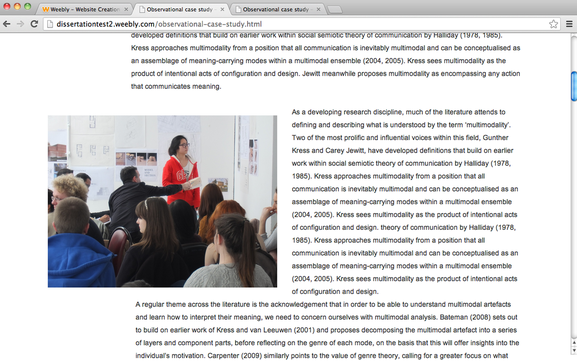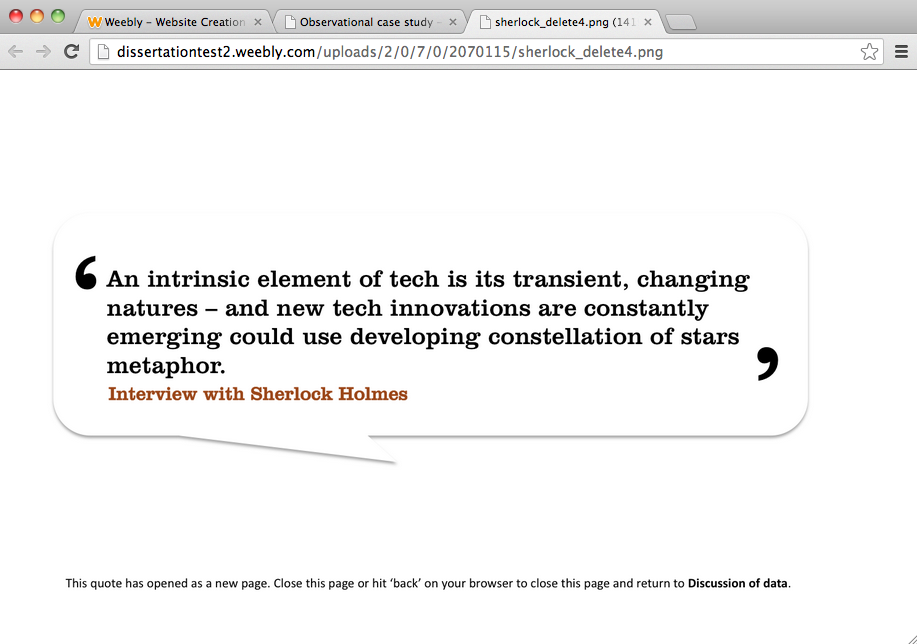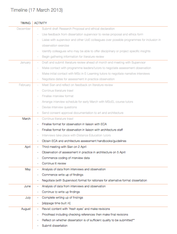|
This won't be a video. I don't have the time to do it justice. Instead, I'll take photographs of university crests (containing a book) and will put them into a rolling slideshow, as I've just been testing out for the Observation section... If time allows, perhaps I could still try to create a single crest that is more multimodal (or digitally multimodal). That would be quite interesting.
Or perhaps I re-form one or more of the original crests to represent the multimodal university? Again though, I need to be conscious of time so this idea is probably unrealistic.
0 Comments
It's back in! A combination of car travel and students missing appointments meant I had a bit of time to think and write about the observation and, on reflection, I think this could be a strong section. Or maybe it's the caffeine - I'll revisit this after this parents evening and see whether the idea is more or less flat than the cola.
Anyway, now that I've spent some time thinking about it, the section covering Observation of multimodal assessment in Architecture could be nice, short and take a sideways approach to the representation of ideas. Through the combination of text, images (individually embedded or perhaps as rolling sideshows) and the use of one or more Thinglink interactive images it could be a really interesting - and appropriate - way of presenting the gathered data. After all, why would I present an observation of multimodal assessment in predominantly conventional text form? Much better to try and match the representational to the content to be communicated. I also think would make for a more enjoyable and rich 'reader' experience. The observation would follow the Discussion and analysis of data section. It will consider what is observed both in relation to the collected data and also the literature. For instance, I'll think about common themes, differences and opportunities that emerge from the class asked practice that might inform the experience of online tutors. I won't go too heavy on the literature of reference to the data, partly to avoid repetition, partly due to word count and partly so that its more straightforward to write and read. I'm excited about this. I hope my enthusiasm sustains beyond the caffeine fix. Is there a way that, within my text, I can regularly hyperlink to quotes from the data?
This would be in addition to having key quotes reprinted in full. At least, I think it would. Or maybe that wouldn't be necessary. Maybe it would look a bit odd to have both. This might work by having linked text which, when clicked would open up a cut out diagram of the relevant quote, perhaps highlighted as itching a slightly larger part of the transcript, with the other text in faded grey. Ideally, a hover over would work better but I don't think that's possible from a text section in weebly. Maybe though the words could link to images - in a new page - at are themselves uploaded as documents. It'll be worth exploring this as its a more interesting way of presenting the research data and also better exploits the potential of hyperlinks. Actually, if this works, it would make sense to take the same approach when linking to relevant content within my blog (within the rationale section). So rather than linking to the whole blog post (where I would have to highlight the relevant text and tidy up/check what's around it) it would instead link to a cut out. In fact maybe I don't use actual cut outs but instead reproduce the text as if it has been lifted from the blog or transcript, allowing for accompanying biographical or background information as required. This could the date and title of the blog entry from which the text is drawn, and for the interview data. I've been thinking about how I could use this. Will there be room for it Witihin the main body of the dissertation? How and where will it fit in, without going over ground that has ready been covered? How much space should be allocated to it?
I could try and be quite imaginative with this. In my head I'd been thinking that this would be text and photographs. There's an opportunity though to do something more interesting. I could make the write up quite an interesting multimodal artefact in itself, as follows:
Another quite interesting idea... I could create some form of image (annotated photograph, manipulated photo, my own creation) to demonstrate the different modes being employed. This would almost be a scientific e.g. Medical, biological diagram. Maybe do this in thinglink: by hovering over different parts of the diagram, text appears naming the mode. THe pop Up text would be a combination of descriptive dialogue interwoven with literature, for instance a direct quote or a 'see for instance Kress 2001'. A bit like the maps for the NG project, I should take the original photo and do something interesting with it, not least as my own 'people shots' from the observation aren't particularly strong. AS this is in Eca/architecture, maybe I take an artistic or architectural approach to the image. Actually, the idea of architecture is good, although it could cause confusion with the constellation map if it ends up looking like a plan. Maybe just go for something interesting and artistic. It might be difficult to depict the artwork on a people image therefore maybe i create a composite in PowerPoint, with a 'model and sketches' image inset, which I then import to thinglink to make interactive. As per the use of videos within this dissertation, I don't want lots of accompanying explanatory text - this implies a lack of faith in the artefact. This image should work as a stand alone, therefore I'll have the smallest amount of text (as part of the wider text) and then have - 'see image' or perhaps not even that. A reply from Sian in response to my question about the use of video. I can't disagree with any of the below. Basically, it would be good, but its not necessary, and my priority should be the writing.
The video idea was already on hold until I get the writing out of the way, however it has been useful to have this reaffirmed.
I know I'm not supposed to be working on this until the writing is out of the way, however I had half an hour in a cafe over lunch so thought I might as well put it to use. Some thoughts on how the 'campus exploration' video might work:
What follows?
[Lunch ends] As it stands, I could create the following videos:
Another possible idea - interesting and but not essential and definitely extra work - rather than listing the different technologies used in the dissertation (within the Acknowledgement), this could be in the form of a video where I have very short clips of the different technologies/spaces being used for the purpose of composition. Actually, I really quite like this and will come back to it. Rather than screen shots which aren't always that effective, it could HD video of me (well, my hands) using the stuff. There's room for a bit of humour here - maybe I also have some written or sketched note. Yes, I'll look forward to revisiting this when time allows. Distribution: what I've proposed above would see the inclusion of video in the Literature Review, the Conclusion and the Acknowledgements sections. Right then.
I won't create a soundtrack for the whole dissertation or any of the major component parts. Instead, I'll create a unique audio track for each of the videos that I propose to make. These currently consist of: 1 defining multimodality; 2. evolution of the university crest, and; 3. a walk around the university. 4. conclusion video Each of these videos will be short, therefore I'll be looking for short audio soundtracks. I could still continue with the idea of the Eno-esque ambient background (for some at least - not sure if that would suit the 'crest' video) but this would be complemented by other (relevant) sound effects, audio or music. I would match the audio to what's on screen, rather than the 'music to read by' approach I was previously favouring (albeit uncertainly). I'm not sure this will save time, however it will feel like I'll be creating a soundtrack with purpose, both in the sense that I will have a sense of purpose, and also in that the the soundtrack will serve a clear, rather than abstract, function. First day back at work after the summer holidays and I had some thinking time in the car. At the time it felt like a had a rush of reasonable ideas, but we've been before. Nevertheless, it was good to have the space to think creatively and imaginatively about things with only She and Him and fellow traffic as distractions.
Once again, I began to question the format I'm taking in representing my ideas within this dissertation. A website is fit for purpose but isn't particularly interesting. It could prove to be polished, but it won't be clever. I just keep coming back to the fact that however imaginative the different components within the website might be, I'm stuck with the same -largely conventional canvas. It's still a website, even it includes video, photography and sound. I started then - just for a bit of fun - to think about how, in an ideal world, the presentation of ideas could be really imaginative. A thought flickered for a moment of making the whole thing a film. This wouldn't be 15,000 captioned words pasted over photographs. It would rip up the conventions of a dissertation: the images would stand alone, rather than needing detailed explanation. The soundtrack would be an genuine soundtrack, not some music to listen to whilst reading text on the page (and the more I think about that idea, the less convincing it becomes). It would be playful, personal, engaging. That would be great. In an ideal world. Back on the road in EH14 - without the luxury of time the above approach would require - it struck me that this is one of the challenges (for the student/author/composer) of taking a digital multimodal approach to the representation of ideas. Here's the cold reality of the situation: I could have had this dissertation finished and submitted some time ago if I'd decided to present it in traditional format. I could have gone on holiday with the anxiety about needing to submit and the compulsion to spend time writing ideas (enjoyable as this was). The thousands of words within this blog that are dedicated to the form of my dissertation are testament to the time penalty of taking an alternative approach to the presentation of my ideas. Without question I've spent hundreds (and counting) of hours thinking, drafting and experimenting with how I might represent my dissertation ideas: these aren't concerns for the student who elects to put their ideas in the form of a traditional text-based dissertation. So maybe there's a point here to feed into my dissertation at some point. Taking a non-conventional, digital approach offers greater creative and communicational freedom, but it also poses some difficult questions. By abandoning a traditional representational form I'm taking on more responsibility and putting myself under more pressure. If I'd gone for a straightforward essayistic approach, where the format is predetermined, I wouldn't have to make decisions about how the dissertation should look (or sound) and how best to represent my ideas. Taking a traditional text-based approach would be easier, but it would also be less interesting (for author and audience). Here's an idea that came to me today.
Rather than simply using words in an attempt to describe and define multimodality, I could make a short video that would be an multimodal way of doing so. If I think this is any good in the morning, I'll explore it in greater depth in due course. Maybe later in the week. It would be embedded either within the literature review or in the introductory section where I'm defining terms. It would make use of text (including quotes), photography and sound. Actually, here's a thing: maybe I could try and use a few short videos across the the dissertation. This would include the 'defining multimodality' video above, the exploration of existing multimodal practice in the form of a walk around the campus (as described unsatisfactorily in the Lit Review) and perhaps also the idea of an evolving university crest (building on Ray Land's work) to reflect changing literacy within the academy (that I've been toying with for a while). In each case, this is a more authentic way of covering those particular areas of content (rather than in text alone). Each video would need to be embedded in the text, although with little fuss - if they're good enough they should work in their own right, without the need for explanatory text. They should stand alone as artefacts, while also working as part of the assemblage on that particular screen. The videos will complement and, to an extent, reproduce some what's in the surrounding text. But they'll also go further. The use of sound, colour and design will add richness. By including these videos I'll be exploring how digital multimodality can extend beyond 'words on page or screen' and I should acknowledge this in the rationale and also put a short explanation in the 'user information' that will be linked on the front page of the website. In taking this approach, I'm taking a digital multimodal approach to themes within the dissertation that cannot be adequately described solely through words. Assuming I do this at all, I'll need to do it sparingly, not least as each video will a take fair bit of time to prepare (much more so than would be case for text on the page/screen). I like the idea of maybe having up to three videos within key sections of the dissertation, if that's possible. Another side effect of this is that this might replace the need for a 'soundtrack' for the wider dissertation. That's quite attractive, actually, as it makes more meaningful use of sound than simply a 'something to listen to whilst reading/viewing this stuff. I'll write about how this might be practically/technically realised at a later date. |
Categories
All
Archives
October 2013
TimelineOther stuff
|


